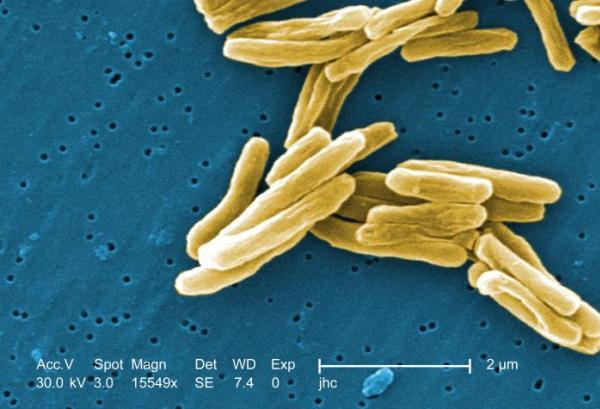5 Most Likely Real-Life Contagions
Intro

In the upcoming movie "Contagion," a cast of Hollywood elites contends with a virus that goes airborne, kills quickly and spreads globally.
Luckily, no real virus fits the description of the fictional pathogen in "Contagion," but there are contenders that have some of its attributes: airborne, global or deadly.
Here are the top five pathogens that are most similar to the fictional disease in "Contagion."
Influenza

Given the 1918 scourge that killed millions, and the worry that the 2009 H1N1 outbreak brought, epidemiologists are willing to wager that influenza has the potential to turn into a deadly pandemic.
Flu viruses spread on airborne droplets when someone coughs, sneezes or talks. But people can also pick up the virus indirectly, because it can survive for some time on objects such as phones, buttons or keyboards, according to the Mayo Clinic.
Fevers, aches, sore throats, cough and fatigue are hallmarks of the flu. But the respiratory illness may bring complications such as pneumonia, which can be deadly if a strain is particularly virulent, according to the Centers for Disease Control and Prevention (CDC).
And because the flu mutates in animals and can jump to humans, epidemiologists could never rid humans of influenza through vaccination campaigns, said Dr. Tomas Aragon, director of the University of California, Berkeley, Center for Infectious Disease and Emergency Readiness.
Get the world’s most fascinating discoveries delivered straight to your inbox.
"All the subtypes live in wild birds, and they're mutating, and when they come to the human population, we're not immune," Aragon said.
SARS

When the virus that causes severe acute respiratory syndrome (SARS) struck in 2003, it showed how public health systems could react to an outbreak, and at the same time, how a deadly pandemic may hit the globe. That year there were an estimated 8,000 cases and 750 deaths, according to the CDC and the National Institutes of Health.
The SARS virus is a virulent mutation of a virus in the coronavirus family viruses in this family also cause the common cold.
"It was so pathogenic, that almost everybody who became infected became ill," Aragon said of the 2003 SARS outbreak in East Asia.
SARS symptoms such as fever, headache and cough often quickly turned to pneumonia. SARS had a 9 to 12 percent death rate among people who were diagnosed, according to the NIH. And in people older than 65, the death rate was more than 50 percent.
Aragon credits swift international actions, including closing schools, quarantining sick people and issuing travel advisories, with stemming a potential global pandemic.
SARS spreads through airborne droplets much like the flu, but much remains unknown about its origins; the virus could mutate again in animal hosts and jump to humans.
"SARS, even though it's disappeared, could return at any time," said Dr. Ali S. Khan, director of the CDC's Office of Public Health Preparedness.
Anthrax

Public health experts must also look beyond nature for unknown pandemic threats. Diseases that are generally under control in nature could turn into deadly outbreaks if used as a bioterrorism weapon.
"Anthrax is most concerning," said Aragon, of potential bioterrorism threats.
Anthrax bacteria (Bacillus anthracis) can infect humans in three ways, and each route of transmission leads to different symptoms, ranging from an itchy sore on the skin to breathing problems, fever and shock. About 95 percent of known anthrax infections are passed to humans from livestock through skin contact, although eating tainted meat can also transfer the bacteria, according to the NIH and CDC.
But in 2001, 22 people became ill after breathing in anthrax spores sent through the mail. Inhaling anthrax can lead to a deadly infection that starts several days to weeks after exposure. Once anthrax spores germinate, they release toxic substances that cause internal bleeding, swelling and can kill tissue, according to the NIH.
Although antibiotics can usually cure a skin anthrax infection, the CDC estimates 75 percent of people who contract anthrax by inhaling spores will die, even with medical care.
Drug-resistant tuberculosis

Some pathogens cause trouble not so much because they kill quickly, but because they can't be killed easily.
"Another infection that's widespread in the world, and we are holding it at bay, is tuberculosis, or TB," said Dr. William Schaffner, former board member of the Infectious Diseases Society of America.
Spread through airborne droplets in a cough, TB can survive as a low-grade infection in a person for years slowly spreading to others throughout a community. Symptoms include a chronic cough, severe weight loss and night sweats.
TB killed 1.7 million people in 2009, making it one of the world's deadliest infectious diseases, according to the World Health Organization. Many of these deaths could be prevented if patients were treated with a six-month course of medication.
Moreover, in the past 15 years, drug-resistant forms of TB have threatened efforts to fight the disease. As TB bacteria evolve to be drug-resistant, doctors worry they will loose ground fighting a disease that afflicted much of the world before the development of antibiotics.
Ebola

The Ebola virus might not kill as many people each as TB, but it is still one of the deadliest pathogens on record and a subject in popular media since it was discovered in 1976.
Ebola can silently incubate in a person for two to 21 days, after which a person may suffer an abrupt fever and headache, according to the CDC. Joint and muscle aches, sore throat and weakness usually give way to diarrhea, vomiting and stomach pain. Some people with Ebola will have a rash, red eyes, internal and external bleeding, according to the CDC.
All four strains of the Ebola virus known to infect humans are spread through contact with blood, tissue or bodily fluids, according to the World Health Organization. The most virulent strains of Ebola kill 25 to 90 percent of people they infect. All outbreaks of Ebola have occurred in Africa, and scientists hypothesize the virus is carried within wild animals, according to the CDC.



